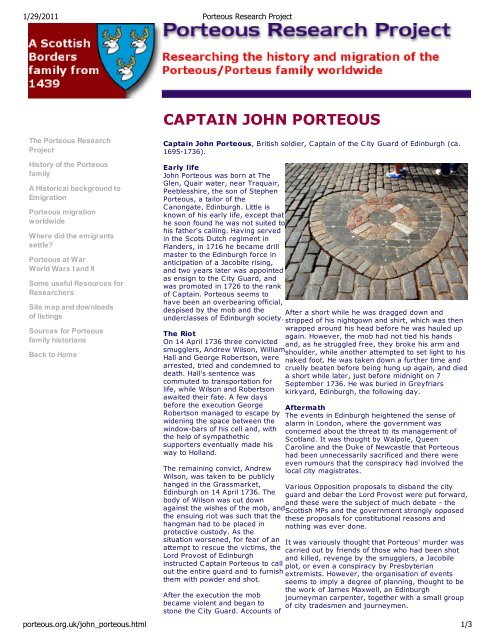CAPTAIN JOHN PORTEOUS - waughfamily.ca
CAPTAIN JOHN PORTEOUS - waughfamily.ca
CAPTAIN JOHN PORTEOUS - waughfamily.ca
You also want an ePaper? Increase the reach of your titles
YUMPU automatically turns print PDFs into web optimized ePapers that Google loves.
1/29/2011 Porteous Research Project<br />
The Porteous Research<br />
Project<br />
History of the Porteous<br />
family<br />
A Histori<strong>ca</strong>l background to<br />
Emigration<br />
Porteous migration<br />
worldwide<br />
Where did the emigrants<br />
settle?<br />
Porteous at War<br />
World Wars I and II<br />
Some useful Resources for<br />
Researchers<br />
Site map and downloads<br />
of listings<br />
Sources for Porteous<br />
family historians<br />
Back to Home<br />
This website is dedi<strong>ca</strong>ted<br />
to the memory of<br />
Robert Richard<br />
<strong>PORTEOUS</strong>,<br />
Lance-corporal,<br />
US Marine Corps, of<br />
Indianapolis, Indiana,<br />
USA,<br />
killed in action in<br />
Vietnam,<br />
5 February 1967,<br />
born on the same day as<br />
the author of this site<br />
<strong>CAPTAIN</strong> <strong>JOHN</strong> <strong>PORTEOUS</strong><br />
Captain John Porteous, British soldier, Captain of the City Guard of Edinburgh (<strong>ca</strong>.<br />
1695-1736).<br />
Early life<br />
John Porteous was born at The<br />
Glen, Quair water, near Traquair,<br />
Peeblesshire, the son of Stephen<br />
Porteous, a tailor of the<br />
Canongate, Edinburgh. Little is<br />
known of his early life, except that<br />
he soon found he was not suited to<br />
his father's <strong>ca</strong>lling. Having served<br />
in the Scots Dutch regiment in<br />
Flanders, in 1716 he be<strong>ca</strong>me drill<br />
master to the Edinburgh force in<br />
anticipation of a Jacobite rising,<br />
and two years later was appointed<br />
as ensign to the City Guard, and<br />
was promoted in 1726 to the rank<br />
of Captain. Porteous seems to<br />
have been an overbearing official,<br />
despised by the mob and the<br />
After a short while he was dragged down and<br />
underclasses of Edinburgh society. stripped of his nightgown and shirt, which was then<br />
wrapped around his head before he was hauled up<br />
again. However, the mob had not tied his hands<br />
and, as he struggled free, they broke his arm and<br />
The Riot<br />
On 14 April 1736 three convicted<br />
smugglers, Andrew Wilson, William<br />
Hall and George Robertson, were<br />
arrested, tried and condemned to<br />
death. Hall's sentence was<br />
commuted to transportation for<br />
life, while Wilson and Robertson<br />
awaited their fate. A few days<br />
before the execution George<br />
Robertson managed to es<strong>ca</strong>pe by<br />
widening the space between the<br />
window-bars of his cell and, with<br />
the help of sympathethic<br />
supporters eventually made his<br />
way to Holland.<br />
The remaining convict, Andrew<br />
Wilson, was taken to be publicly<br />
hanged in the Grassmarket,<br />
Edinburgh on 14 April 1736. The<br />
body of Wilson was cut down<br />
against the wishes of the mob, and<br />
the ensuing riot was such that the<br />
hangman had to be placed in<br />
protective custody. As the<br />
situation worsened, for fear of an<br />
attempt to rescue the victims, the<br />
Lord Provost of Edinburgh<br />
instructed C aptain Porteous to <strong>ca</strong>ll<br />
out the entire guard and to furnish<br />
them with powder and shot.<br />
After the execution the mob<br />
be<strong>ca</strong>me violent and began to<br />
stone the City Guard. Accounts of<br />
shoulder, while another attempted to set light to his<br />
naked foot. He was taken down a further time and<br />
cruelly beaten before being hung up again, and died<br />
a short while later, just before midnight on 7<br />
September 1736. He was buried in Greyfriars<br />
kirkyard, Edinburgh, the following day.<br />
Aftermath<br />
The events in Edinburgh heightened the sense of<br />
alarm in London, where the government was<br />
concerned about the threat to its management of<br />
Scotland. It was thought by Walpole, Queen<br />
Caroline and the Duke of New<strong>ca</strong>stle that Porteous<br />
had been unnecessarily sacrificed and there were<br />
even rumours that the conspiracy had involved the<br />
lo<strong>ca</strong>l city magistrates.<br />
Various Opposition proposals to disband the city<br />
guard and debar the Lord Provost were put forward,<br />
and these were the subject of much debate - the<br />
Scottish MPs and the government strongly opposed<br />
these proposals for constitutional reasons and<br />
nothing was ever done.<br />
It was variously thought that Porteous' murder was<br />
<strong>ca</strong>rried out by friends of those who had been shot<br />
and killed, revenge by the smugglers, a Jacobile<br />
plot, or even a conspiracy by Presbyterian<br />
extremists. However, the organisation of events<br />
seems to imply a degree of planning, thought to be<br />
the work of James Maxwell, an Edinburgh<br />
journeyman <strong>ca</strong>rpenter, together with a small group<br />
of city tradesmen and journeymen.<br />
porteous.org.uk/john_porteous.html 1/3
1/29/2011 Porteous Research Project<br />
events are confused, but what is<br />
certain is that C aptain Porteous<br />
instructed his men to fire above<br />
the heads of the crowd but, in so<br />
doing, they shot and wounded<br />
people in the windows of the high<br />
tenement buildings opposite. The<br />
crowd be<strong>ca</strong>me increasingly violent<br />
and, as panic set in, Captain<br />
Porteous ordered the guard to<br />
shoot into the mob, which led to<br />
the deaths of six people in all.<br />
The Trial and Appeal<br />
Porteous was arrested the same<br />
afternoon and charged with<br />
murder. He was tried at the High<br />
Court of Justiciary on 5 July 1736,<br />
where a majority of witnesses<br />
testified that Porteous had<br />
personally fired into the crowd on<br />
14 April, although sixteen others<br />
said they had not seen him do so.<br />
Feelings were running high in<br />
Edinburgh and the jury<br />
unanimously found Porteous guilty<br />
of murder. He was sentenced to<br />
death, the execution was set to<br />
take place in the Grassmarket on<br />
8 September 1736. Porteous was<br />
imprisoned in the Tolbooth, near<br />
St Giles church.<br />
Events in Scotland alarmed the<br />
government in London, and Sir<br />
Robert Walpole attempted to<br />
influence events by asking his<br />
representative in Edinburgh to<br />
become involved. But he had<br />
mis<strong>ca</strong>lculated, underestimating the<br />
depth of feeling in Scotland. A<br />
formal appeal was petitioned and<br />
the execution was deferred.<br />
However, despite a reward of £200 being made<br />
available by the government for information, those<br />
responsible for the murder of Porteous were never<br />
brought to justice.<br />
The events surrounding the Porteous Riots form<br />
part of the early chapters of the novel 'The Heart of<br />
Mid-Lothian' by Sir Walter Scott (1818), where they<br />
are recorded in graphic detail.<br />
Porteous and golf<br />
John Porteous had been an early exponent of the<br />
game of golf. It is recorded that in 1724 "A solemn<br />
match of golf" between the Hon. Alexander<br />
Elphinstone and John Porteous be<strong>ca</strong>me the first<br />
match to be reported in a newspaper. Both players<br />
were said to have exhibited great skill, and such<br />
was the interest in the match that it was attended<br />
by James, Duke of Hamilton and George, Earl of<br />
Morton, as well as a large crowd of spectators. The<br />
wager was twenty guineas and Elphinstone was the<br />
winner of the match.<br />
Trivia<br />
The final resting place of John Porteous in<br />
Greyfriars kirkyard had for more than two hundred<br />
years been marked by a small square stone with<br />
the single letter 'P' and the date 1736. More<br />
recently, this has since been replaced with a<br />
headstone of Craigleith stone, bearing the<br />
inscription 'John Porteous, a <strong>ca</strong>ptain of the City<br />
Guard of Edinburgh, murdered September 7, 1736.<br />
All Passion Spent, 1973'.<br />
The spot where Porteous died is today marked by a<br />
memorial plate in the Grassmarket. The site of the<br />
infamous Tolbooth Prison is marked by paving<br />
stones arranged in the form of a heart, 'The Heart<br />
of Midlothian'. Tour guides will assure you that,<br />
even today, passers-by will spit on the spot, a<br />
tradition originally intended to demonstrate their<br />
contempt for the hated Tolbooth.<br />
Death<br />
References<br />
However, public resentment at a Scott, Sir Walter. "The Heart of Mid-Lothian", (1818)<br />
possible reprieve was such that a "The Encyclopaedia Britanni<strong>ca</strong>" (1911)<br />
plot to murder Captain Porteous Lever, Sir Tresham. "Sir Walter Scott and the<br />
was hatched, and when the Murder of Porteous" (1971)<br />
authorities heard of this it was Porteous, Barry. "The Porteous Story", (Porteous<br />
decided to increase the guard at Associates, 1975)<br />
the Tolbooth prison. However, on K.J. Logue. "John Porteous" in Oxford Dictionary of<br />
the evening before this was due to National Biography (Oxford: University Press, 2005)<br />
happen, a large crowd of over four<br />
thousand gathered at Portsburgh, Photograph above by the author<br />
west of the city.<br />
porteous.org.uk/john_porteous.html 2/3
1/29/2011 Porteous Research Project<br />
Making their way across the<br />
Grassmarket to the Cowgate and<br />
up the High Street, the mob<br />
converged on the Tolbooth, where<br />
they were eventually able to<br />
overpower the guards. Porteous<br />
was dragged from his cell and up<br />
the Lawnmarket towards the West<br />
Bow and the Grassmarket, where<br />
he was lynched from a dyer's<br />
pole, using a rope taken from a<br />
lo<strong>ca</strong>l draper's shop.<br />
Next page<br />
Back to Introduction<br />
Site map | The Porteous Associates | Porteous Family DNA Project | Porteous IGI<br />
Database Search | Porteous UK Census Search | Links to other Porteous genealogy<br />
sites | Email Webmaster<br />
The contents of this site are copyright © 2000–10, Bruce Porteous, Norwich, England<br />
All rights reserved<br />
Last updated on November 12, 2010<br />
porteous.org.uk/john_porteous.html 3/3







![SS Sir Francis [+1917] - waughfamily.ca](https://img.yumpu.com/49438251/1/190x245/ss-sir-francis-1917-waughfamilyca.jpg?quality=85)








